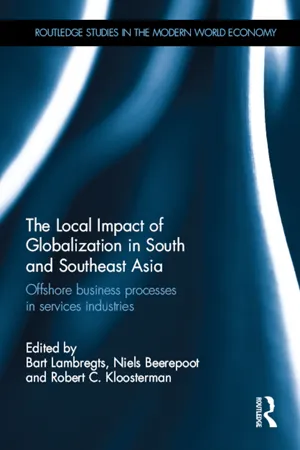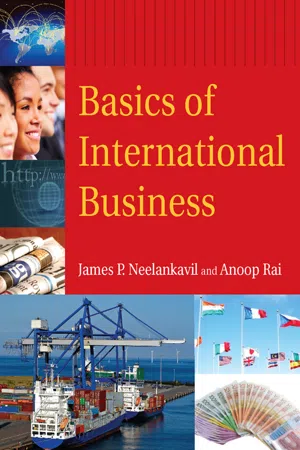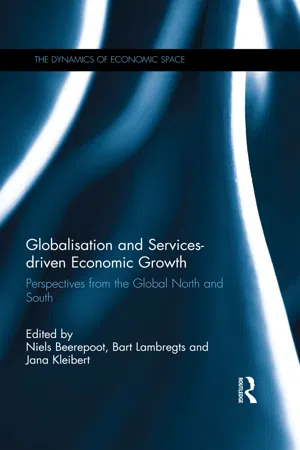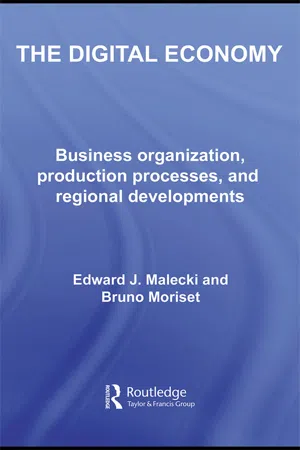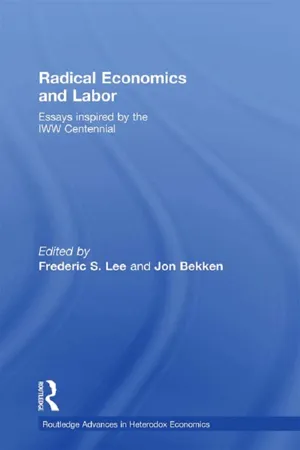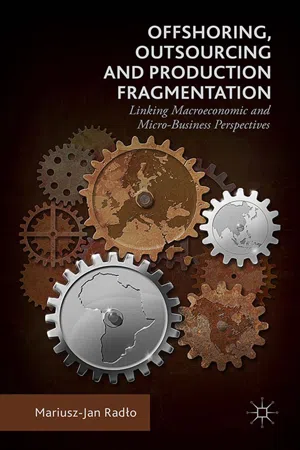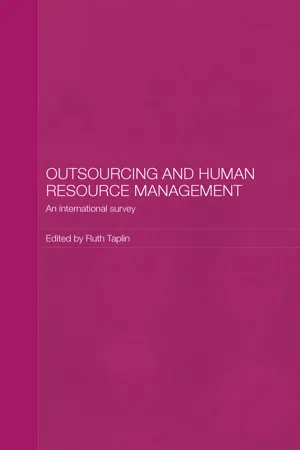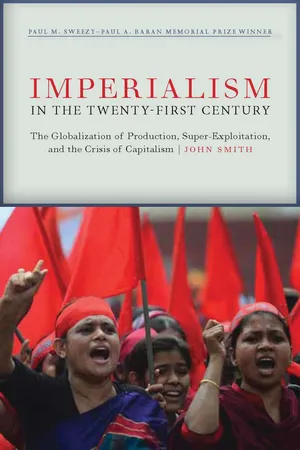Economics
Offshoring
Offshoring refers to the practice of a company relocating some of its business processes or services to another country, often to take advantage of lower labor costs or other economic benefits. This can involve outsourcing tasks such as manufacturing, customer service, or software development to a foreign location. Offshoring has implications for global trade, employment, and economic competitiveness.
Written by Perlego with AI-assistance
Related key terms
Related key terms
1 of 4
Related key terms
1 of 3
11 Key excerpts on "Offshoring"
- eBook - ePub
Offshoring of white-collar services
Business and economic perspective
- Artur Klimek(Author)
- 2020(Publication Date)
- De Gruyter(Publisher)
1 Past developments and recent trends in Offshoring of white-collar services1.1 Offshoring and offshorability
Offshoring adds the international context to sourcing decisions of firms. International sourcing is defined as “the total or partial movement of business functions (core or support business functions) currently performed in-house or currently domestically sourced by the resident enterprise to either non-affiliated (external suppliers) or affiliated enterprises located abroad” (Eurostat, 2019 ).There is no commonly accepted definition of Offshoring, what makes systematic statistical analyses very difficult. The issue is even more evident for service Offshoring, where the support of private research institutions enriches understanding of the industry and its economic impact (United States Government Accountability Office, 2004 ). A very simple definition of Offshoring of services describes it as “the transnational relocation or dispersion of service related activities that had previously been performed in the home country” (Doh, Bunyaratavej, & Hahn, 2009 , p. 926). Jensen, Larsen, and Pedersen (2013 , p. 315) also use a similar approach to define Offshoring as “the relocation of organizational tasks and services to foreign locations”.Statements that Offshoring means moving activities from high-cost countries to low-cost ones, or from highly developed to less developed countries are no longer justified. Nevertheless, the common characteristics of the Offshoring destinations has been a certain level of underdevelopment. It was the case for the Caribbean or Ireland, especially in the beginning of the interest in Offshoring. The basic motive of the cost arbitrage was supported by the financial incentives and loose legal framework in host countries. The evidence from US Offshoring firms confirms that the propensity of firms to source from a foreign supplier falls with the rising rigidity in the host country labour market (Kohler & Kukharskyy, 2019 - eBook - ePub
Call Centers and the Global Division of Labor
A Political Economy of Post-Industrial Employment and Union Organizing
- Andrew J.R. Stevens(Author)
- 2014(Publication Date)
- Routledge(Publisher)
outsourcing , which encompasses the contracting out of business operations to an outside provider. This process can entail a range of corporate activities from the use of staffing agencies to employing the services of outside expertise or other firms to perform non-core functions. The process, also called “externalization”, reflects an increasing division of labor linked to technological innovation and changing patterns of business operations (Majluf 2007). Both practices go hand in hand, but in many cases the Offshoring of work involves in-house operations—meaning owned and controlled by a single firm, and not subcontracted to a third party—established in a different location and possibly through the use of subsidiaries, which take the form of intra-firm trade.Debates surrounding free trade agreements emphasize the extent to which developing economies should be linked to their wealthy counterparts, which provided the basis for the Doha round of World Trade Organization negotiations. Finding new sources of inexpensive labor is germane to the development of a global division of knowledge labor. Critics suggest that the richest countries have the most to gain when developing regions engage in these types of agreements (Jomo and von Arnim 2008). Even when the positive spillover effects of Offshoring are included—such as the transfer of technology, skills, management structures, increased tax revenues, investment, foreign exchange, and new employment opportunities—the problem of uneven development remains prevalent.Economic development, enabled through Offshoring and FDI, is conditional on the prospects for an economy to move up the value chain and provide higher value-added goods and services. Without a broader expansion of skill-demanding industries, productivity growth and employment remain isolated to particular sectors and a relatively small percentage of the labor market (Paus and Shapiro 2007). Evidence from leading developing economies shows that productivity has far outpaced employment growth, meaning that the expansion of new technologies and capital has not generated economy-wide benefits (Conference Board 2008). Despite the obvious inequities, scholars and industry leaders maintain that in high-tech industries, the fortunes of firms in the wealthy economies are dependent upon the labor and knowledge of workforces in developing countries. This is evidenced by the fact that over half of Fortune 500 companies are now customers of the Indian IT industry, several of which have established subsidiaries on the subcontinent (Sahay, Nicholson, and Krishna 2003).4 - eBook - ePub
- John Urry(Author)
- 2014(Publication Date)
- Polity(Publisher)
So it has become clearer that much of importance in economic, social and political life involves movement, relocation and concealment. Rather than there being a general process of increased open movement across borders, movement is often out of sight and involves elaborate forms of secrecy. A borderless world develops new borders and new secrets. Borders are regularly created, policed and surveilled. This book describes how a world of accelerated movement across borders is a world of secrets and sometimes lies.There has come into being a general offshore world which is restructuring global power and domination. This book dissects these Offshoring practices and examines the offshore world being assembled. An Offshoring analysis examines the moving of resources, practices, peoples and monies from one national territory to another, and how they are wholly or partly hidden from the view of the public and/or public authorities. Such Offshoring normally involves rule-breaking in one or more of three ways. There is the getting around of rules and regulations in ways that are simply illegal (tax evasion); there is going against the spirit of the law even if what is done is technically ‘legal’ (tax avoidance); and there is the use of laws in one jurisdiction to undermine laws that operate in another (much maritime practice). The point of Offshoring is to operate outside sets of specific regulations, often going ‘off-state’, involving some combination of these different forms of rule-breaking.Offshoring practices have been made possible by various ‘post-national’ systems of contemporary mobility, although this is not to suggest that there was once a ‘golden age’ when secrets were absent. These systems include container-based cargo shipping; extensive aeromobility; the countless virtual worlds; car and lorry traffic; electronic money transfer systems; taxation, legal and financial expertise enabling particular national systems of regulation to be evaded; and proliferating ‘mobile lives’ engendered through frequent legal and illegal movement across borders. Each such system entails a combination of mobilities and immobilities. Central to most systems are de-localised virtual environments enabling information, money, trades, images, connections and objects to move digitally as well as physically, often along routeways in the shadows. Virtual environments are part and parcel of contemporary Offshoring and the de-localising of production, consumption and sociability that characterises the past few decades. - Bart Lambregts, Niels Beerepoot, Robert Kloosterman, Bart Lambregts, Niels Beerepoot, Robert C. Kloosterman(Authors)
- 2015(Publication Date)
- Routledge(Publisher)
To be credited for the global shift in services production is the increased tradability of various services products, enabled by important advances in information and communication technologies (ICT). The latter, over the past 25 years or so, have paved the way for the massive digitization of business processes and the electronic transfer of the associated services products. Helped further by diminishing trade barriers and the rise of a well-educated and IT-literate labour force in the Global South, firms today enjoy literally a world of opportunities to engage in labour arbitrage and expand their production networks. The IT-enabled unbundling of service production processes allows for such processes to be outsourced and/or offshored. While outsourcing refers to the migration of production activities across a firm’s organizational boundaries (i.e. contracting out a business process to a third party), Offshoring concerns the relocation of activities overseas. Offshoring may or may not involve outsourcing. The former is often referred to as ‘offshore outsourcing’, the latter as ‘captive Offshoring’.Since its inception, services Offshoring has become an increasingly complex phenomenon. Initially, work mainly flowed from the Global North to the Global South. Today’s movements are more intricate, with investments and jobs also migrating in the opposite direction and between countries in the Global South itself. Patterns of specialization emerge in result, sometimes based simply on the kind of language that is locally mastered (e.g. English, Spanish, French, Japanese) but increasingly informed by more sophisticated differences in skills availability (e.g. analytical and creative skills). Motives to engage in services Offshoring have become more variegated too. While initially Offshoring was primarily about achieving cost benefits through labour arbitrage, an emerging motive these days is for firms to source skills that are increasingly hard to find ‘at home’ but still in abundant supply overseas (Bunyaratavej et al. 2011).The past years also have seen an impressive increase in the variety of services activities being offshored. No longer does it concern customer relations services (call centres), data processing (back office activities) and relatively simple IT services alone. Today’s offshorable services are increasingly knowledge intensive and include a choice of financial, legal, engineering, design and medical services, along with an expanding array of ever more advanced IT services (such as application development) and even research and development. In tandem with the proliferation of offshorable services, a fairly complex nomenclature has developed. The literature is peppered with acronyms such as BPO, KPO, LPO, BPM, IT-BPO, ITES-BPO and others, with BPO standing for business process outsourcing, KPO for knowledge process outsourcing, LPO for legal process outsourcing and BPM for business process management. Each refers to different subsectors or segments of the business process outsourcing industry. The acronyms IT-BPO and ITES-BPO emphasize that services outsourcing and Offshoring are strongly information technology-based, with ITES standing for information technology enabled services. In this volume ITES-BPO is used to refer to the industry at large, while other acronyms may be used to identify particular subsectors or processes.- eBook - ePub
- James P. Neelankavil, Anoop Rai(Authors)
- 2014(Publication Date)
- Routledge(Publisher)
3Before we discuss different aspects of the new form of outsourcing, we define new terms that have crept into the English lexicon over the past few decades: Offshoring, inshoring , and near-shoring . We begin with the generic term outsourcing .OUTSOURCING , OFFSHORING , INSHORING , AND NEAR -SHORING
OUTSOURCING
The term “outsourcing” denotes the contracting by a company of selected work, previously performed in-house, to a third-party vendor. The location of the third-party vendor is immaterial; it may be domestic or overseas. The work may be relatively minor and peripheral to the company’s main activity, for example, janitorial services, facility maintenance, landscaping, or worker training. Alternatively, it can involve work that is more integral to the core business of the company, such as manufacturing, accounting, payroll, or marketing.A company may choose to manufacture and assemble all the components of its product in-house, or it may choose to manufacture only selected components that are considered noncore elements. Another option, or business model, for a company is to outsource the manufacturing of all the components and perform only the assembly work in-house. A third possible model is to outsource the design, marketing, and accounts receivables (collection of payments) services while performing the manufacturing and operations in-house. Outsourcing can include a combination of core and noncore activities, and the actual model chosen will depend on the strategic mission of the company and potential cost savings. - eBook - ePub
Globalisation and Services-driven Economic Growth
Perspectives from the Global North and South
- Niels Beerepoot, Bart Lambregts, Jana Kleibert(Authors)
- 2016(Publication Date)
- Routledge(Publisher)
The chapter is organised as follows. The next section reviews relevant prior literature on service Offshoring and regional development and develops an analytical framework to guide the empirical analysis of the case. This is followed by an explanation of the study methodology and an overview of the case study region. The main empirical body of the chapter comprises three sections that: (1) Profile Northern Ireland’s inward-investment performance since the mid-1990s and chart the rise of services projects; (2) Explore the ‘structural characteristics’ of the leading offshore services investors in the region (including various subsidiary attributes and their network positions); and (3) Examine some of the employment impacts of these projects on the region. The chapter concludes by considering the implications of the study and making some suggestions for further research.Relevant literature and analytical themes
Offshoring and outsourcing, services FDI and host economies
Service Offshoring and outsourcing can be understood in the context of various changes in business strategy and organisation, technology and international political economy. In the contemporary global economy, multinational firms are under intense competitive pressures that require them to seek cost efficiencies and improve their capabilities right across the value chain (Yeung and Coe, 2015 ). In pursuing these twin imperatives, business scholars observe an increasing tendency – facilitated by technological advances and the rise of emerging economies – for firms to ‘fine-slice’ their value-chains and ‘unbundle’ or ‘functionally decouple’ discrete activities and tasks from other related parts of the value chain and relocate them – both geographically, via ‘Offshoring’, and organisationally, via ‘outsourcing’ (Buckley and Strange, 2015 ; Contractor et al., 2010 ). Hence, in the case of various ‘corporate services’, there has been an upsurge in both captive Offshoring FDI projects and also ‘offshore outsourcing’ to TP-BPO vendors, many of which have become sizeable multinationals in their own right (Gereffi and Fernandez-Stark, 2010 ; UNCTAD, 2004 ). From the point of view of host economies, this has presented a new opportunity to attract services FDI – in the form of captive centres and delivery centres operated by TP-BPO vendors.A small but growing literature has sought to explore this phenomenon from the host economy’s perspective. Most authors agree that the primary drivers of this phenomenon are cost-reduction – i.e. efficiency-seeking – and accessing appropriately skilled labour – i.e. resource-/talent-seeking. Therefore, the key location attractors for host economies are said to include pools of available and cost-efficient skilled labour, state-of-the-art ICT infrastructure, suitable office space at competitive rates, a stable and conducive business environment, and cultural affinity with target markets and investor home countries (Breathnach, 2000 ; Dossani and Kenney, 2007 ; Pandy and Rogerson, 2012 ; Sass and Fifekova, 2011 ). Some studies have highlighted the role played by local institutional actors in the process of strategic coupling with services production networks (Kleibert 2014 ; Hardy et al. 2011 ), a factor largely overlooked in the International Business literature (for example Doh et al., 2008 ). Research evidence on the host economy impacts of offshore service-related FDI has produced mixed findings. Some authors have been broadly positive about the volume and quality of employment created in emerging locations (Benner, 2006 ; Kleibert, 2014 ; Sass and Fifekova, 2011 ) whereas others have been more sceptical, highlighting concerns about job quality and durability (Breathnach 2000 ; Hardy et al., 2011 ). There is some agreement – at least in studies on Central and Eastern Europe – that the wider indirect employment, supply chain impacts and spill-over effects of such projects are likely to be quite limited, even by comparison to manufacturing branch plants (Hardy et al., 2011 ; Micek et al., 2011 ). Some authors have observed that service Offshoring investments may exacerbate sub-national inequalities, due to their tendency to gravitate towards larger urban centres with abundant labour supply (Pandy and Rogerson 2012 ; Hardy et al., 2011 - eBook - ePub
The Digital Economy
Business Organization, Production Processes and Regional Developments
- Edward J. Malecki, Bruno Moriset(Authors)
- 2007(Publication Date)
- Routledge(Publisher)
et al. 2006). The same authors regard most of the data from consultancies as “suspect.”The studies measure different sectors of the economy use different measures of the extent of Offshoring (e.g., jobs lost, percent of jobs lost, value of jobs or business lost), and different start and end points. Few of the studies provide details on how they developed their projections which makes it difficult to assess the reasonableness of the assumptions and the soundness of the methodology.(Aspray et al. 2006: 85)Table 6.6 Potential for employment Offshoring worldwide in eight business sectors, 2008However, Offshoring consequences on OECD countries employment can hardly be evaluated by the evolution of official labor statistics, because the causal link between employment decline in a given sector and Offshoring in the same sector is not clearly demonstrated. It is simplistic thinking to conclude that “one job performed offshore” equals “one worker fired or unemployed at home.” The decrease of employment in a given industry is often the result of productivity growth, rather than of Offshoring practices. In US call center activities for example, automation of inbound calls processing, consolidations, and the do-not-call registry are responsible for a large share of employment decline.Many of the jobs in India today are viable only in a low-wage environment and would not exist in the United States. That half a million people are now employed in India’s outsourcing industry does not mean that there could be 500,000 more jobs in the United States. Without Offshoring, companies would scale back or stop offering services like 24/7 customer help. Companies are also using technology to replace many of the jobs at risk in the United States. Automated voice response units are replacing call-center workers, online hotel and airline booking systems are replacing live operators and travel agents, and imaging software is replacing data-entry workers. - eBook - ePub
- Frederic Lee, Jon Bekken(Authors)
- 2009(Publication Date)
- Routledge(Publisher)
The question of the impact of globalization on the capital-labor relationship has to be related to that of the historical evolution of foreign direct investment in countries where wages are lower. In 1913, Rosa Luxemburg (1972: 37) wrote: “Capital cannot do without worldwide means of production and labor-power.” In Luxemburg's time, capital moved to colonies in order to gain access to raw materials. Thus, the production of affiliates in these countries was integrated with the parent companies, but this integration was limited to raw materials. Subsequently, market penetration became another dominant motivation of foreign direct investment in developing countries. In this latter case, capital takes advantage of a more favorable employment relationship, but this is not a substitute for the relationship existing in developed countries since the production is oriented toward local markets. The situation is completely different when capital moves into low-wage countries in order to serve markets in developed countries. Then capital avoids the constraining employment relationship that has been set, after a long history of social conflicts, in developed countries. This situation is rather new in the everlasting antagonism between capital and labor over sharing out value. Relocation of activities and outsourcing to low-income countries gathered momentum since the 1960s and developed on a large scale since the 1990s. The countries on the periphery are not only new markets but also privileged places for obtaining surplus value.Offshoring and outsourcing take place in the broader process of production rationalization, on a world scale, led by the transnational corporations. It means a much deeper integration of production than before, as evidenced by intra-firm trade. This fact is overlooked by all those who see nothing new in the current process of globalization. In particular, the division of labor, set by the multinationals between developed and emerging countries, is rapidly evolving. That means an extension of the field in which workers can be played off against one another.Characteristics of global labor arbitrage
Two characteristics of this labor arbitrage should be underlined. First, for the situation of labor in the developed countries, there is a basic difference between the impact of Offshoring and outsourcing in low-wage countries and the effects of “usual trade” with these countries. Here, “usual trade” refers to international trade other than intra-firm. For the greatest part of the history of capitalism, trade between independent firms made up nearly all international trade, but this is no longer the case. Thus, in 2002, intra-firm trade accounted for 31 percent of U.S. exports of goods and 38 percent of U.S. imports. In international trade between independent firms, as delineated by standard theories, competition between workers is limited because the levels of labor productivity between developed and developing nations differ greatly. Things change a lot when workers belong to the same transnational company. All over the world, firms implement similar technologies and types of organization, with variation in the capital-labor combination. Surveys carried out in affiliates of transnational corporations located in developing countries show that their technology levels are not much lower than in the parent companies (Pottier 2003). Their organization is sometimes even more efficient because it is more recent and because its implementation did not have to meet workers' opposition. As a result, the productivity gap within the transnational corporations between plants located in developed countries and those located in developing countries is much lower than the differential in labor costs. Thus, labor costs play a more decisive role in the arbitrage between plants. Therefore, competition between workers according to their location is, by far, much stronger than in the usual trade between nations. The persistent differential between the variations in the cost of labor and the variations in the productivity level within the multinationals shows that the neoclassical hypothesis of a strict relation between wages and labor productivity does not hold. According to the Marxist view, wages are primarily determined by the local conditions of labor-power reproduction. - eBook - ePub
Offshoring, Outsourcing and Production Fragmentation
Linking Macroeconomic and Micro-/Business Perspectives
- Mariusz-Jan Rad?o, Mariusz-Jan Rad?o(Authors)
- 2016(Publication Date)
- Palgrave Macmillan(Publisher)
Markusen (1995) also pointed out that new theories of trade and literature on economic geography and trade significantly enriched the understanding of international trade. In particular, in relation to understanding, the benefits of trade resulting, not from the traditionally understood comparative advantages – including economies of scale, product diversification strategy on imperfect markets or agglomeration and the natural interregional diversity resulting from transport costs, the size of the market or trade policy. However, in all these approaches (as pointed out by Markusen) the company seems still to be a kind of “black box,” as in neoclassical economics. In most cases, the company is treated like a factory or independent production facility producing one good in one location. Moreover, in most cases production done in many manufacturing units, concerning many different products by one organization, goes beyond the scope of the analysis.To summarize the above analysis of international production fragmentation from the perspective of trade theory, it should be noted that Offshoring resulted in a significant change in the structure of international trade. With the division of the production chain into separate components corresponding to the production of various intermediate goods and services, the production of final goods occurred within disintegrated production chains. Various elements of these chains are located in different countries, depending on – among other things – the availability of various resources and their prices as well as factor intensity of the production of various goods. As a result, international trade increasingly began to include indirect goods and services. The different parts of the production chain may, in turn, be connected by hybrid contracts in the case of non-captive Offshoring or may be under one-owner control in the case of captive Offshoring. However, the trade in intermediate goods and services has not eliminated trade in final goods, but has expanded the scope of transactions conducted within companies formerly located in individual economies. - eBook - ePub
- Ruth Taplin(Author)
- 2007(Publication Date)
- Routledge(Publisher)
9 Offshoring to India Human resource challenges Bernard ArogyaswamyThe rapid, almost explosive, growth of East Asian economies in the short span of a little over two decades brought revolutionary economic change to a wide swathe of countries ranging from Japan and South Korea to Malaysia and Thailand. Exports were typically the drivers of growth that was most often launched from a base of imported technologies. While, no doubt, there were variations among the countries’ strategies (the Japanese, for instance, often tested their products in the heat of intense local competition; South Korea’s growth was fueled by the chaebol or large conglomerates; Taiwan drew on the energy of small and medium-sized enterprises; and so on), the model was faithfully implemented until domestic markets had expanded sufficiently.1 , 2 Where foreign investments were needed to implement the new technology, by and large, multinational corporations (MNCs) provided both capital and technology with a view to exporting either the finished product, or components for assembly in the country of sale. Over time, as MNCs began to recognize the cost savings they could realize, and developed mechanisms to coordinate far-flung operations in regard to quality and delivery, outsourcing became one of the keys to success in many manufacturing industries. With the emergence of China as a player on the industrial stage in the 1980s, the race to outsource intensified even more.3 , 4 , 5 , 6The impact of outsourcing on consumers in advanced countries (mainly in terms of product price and variety) has rarely been disputed.7 Over the years, observers have, on occasion, been critical of companies shifting jobs abroad, the erosion of critical capabilities, and of foreign governments’ implementation of industrial policy, by supporting local businesses. However, for various reasons, manufacturing outsourcing has proceeded apace and China has emerged as the dominant force as vender both in developed nations and among its neighbors in Asia.8 , 9 - eBook - ePub
Imperialism in the Twenty-First Century
Globalization, Super-Exploitation, and Capitalism's Final Crisis
- John Smith(Author)
- 2016(Publication Date)
- Monthly Review Press(Publisher)
Richard Freeman’s prediction that “if the work is digital—which covers perhaps 10 percent of employment in the United States [around 14 million workers]—it can and eventually will be offshored to low-wage highly educated workers in developing countries,” was widely reported in the U.S. news media. 58 So too an article in Foreign Affairs in 2006 by Alan Blinder, an eminent economics professor at Princeton University, titled “Offshoring: The Next Industrial Revolution?,” which warned “we have so far barely seen the tip of the Offshoring iceberg, the eventual dimensions of which may be staggering.” 59 Suddenly a layer of professional, middle-class workers began to feel the cold breath of global competition. As Gary Gereffi remarked, “While low-cost offshore production had been displacing U.S. factory and farm jobs for decades, the idea that middle-class office work and many high-paying professions were now subject to international competition came as something of a shock.” 60 Under the subheading “This time it’s personal,” Blinder concluded, “Many people blithely assume that the critical labor-market distinction is, and will remain, between highly educated (or highly skilled) people and less-educated (or less-skilled) people…. The critical divide in the future may instead be between those types of work that are easily deliverable through a wire … and those that are not.” 61 Services made up 75 percent of the GDP of “high-income countries” in 2013, but only 22 percent of their gross exports, 62 but this understates their contribution because services also form part of the value added of exported manufactured goods
Index pages curate the most relevant extracts from our library of academic textbooks. They’ve been created using an in-house natural language model (NLM), each adding context and meaning to key research topics.
Explore more topic indexes
Explore more topic indexes
1 of 6
Explore more topic indexes
1 of 4



